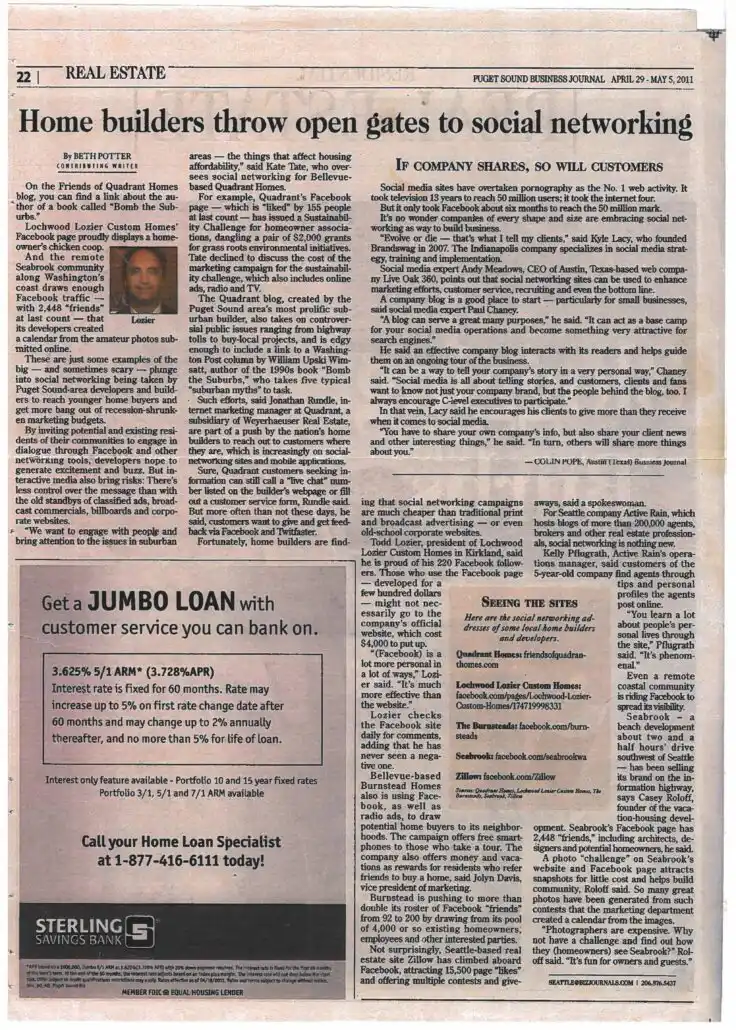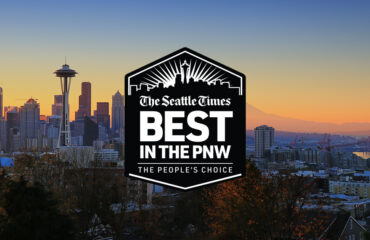On the Friends of Quadrant Homes blog, you can find a link about the author of a book called “Bomb the Suburbs.”
Lochwood Lozier Custom Homes’ Facebook page proudly displays a homeowner’s chicken coop.
And the remote Seabrook community along Washington’s coast draws enough Facebook traffic — with 2,448 “friends” at last count — that its developers created a calendar from the amateur photos submitted online.
These are just some examples of the big — and sometimes scary — plunge into social networking being taken by Puget Sound-area developers and builders to reach younger home buyers and get more bang out of recession-shrunken marketing budgets.
By inviting potential and existing residents of their communities to engage in dialogue through Facebook and other networking tools, developers hope to generate excitement and buzz. But interactive media also bring risks: There’s less control over the message than with the old standbys of classified ads, broadcast commercials, billboards and corporate websites.
“We want to engage with people and bring attention to the issues in suburban areas — the things that affect housing affordability,” said Kate Tate, who oversees social networking for Bellevue-based Quadrant Homes.
For example, Quadrant’s Facebook page has issued a Sustainability Challenge for homeowner associations, dangling a pair of $2,000 grants for grass roots environmental initiatives. Tate declined to discuss the cost of the marketing campaign for the sustainability challenge, which also includes online ads, radio and TV.
The Quadrant blog, created by the Puget Sound area’s most prolific suburban builder, also takes on controversial public issues ranging from highway tolls to buy-local projects, and is edgy enough to include a link to a Washington Post column by William Upski Wimsatt, author of the 1990s book “Bomb the Suburbs,” who takes five typical “suburban myths” to task.
Such efforts, said Jonathan Rundle, internet marketing manager at Quadrant, a subsidiary of Weyerhaeuser Real Estate, are part of a push by the nation’s home builders to reach out to customers where they are, which is increasingly on social-networking sites and mobile applications.
Sure, Quadrant customers seeking information can still call a “live chat” number listed on the builder’s webpage or fill out a customer service form, Rundle said. But more often than not these days, he said, customers want to give and get feedback via Facebook and Twitter.
Fortunately, home builders are finding that social networking campaigns are much cheaper than traditional print and broadcast advertising — or even old-school corporate websites.
Todd Lozier, president of Lochwood Lozier Custom Homes in Kirkland, said he is proud of his 220 Facebook followers. Those who use the Facebook page — developed for a few hundred dollars — might not necessarily go to the company’s official website, which cost $4,000 to put up.
“(Facebook) is a lot more personal in a lot of ways,” Lozier said. “It’s much more effective than the website.”
Lozier checks the Facebook site daily for comments, adding that he has never seen a negative one.
Bellevue-based Burnstead Homes also is using Facebook, as well as radio ads, to draw potential home buyers to its neighborhoods. The campaign offers free smartphones to those who take a tour. The company also offers money and vacations as rewards for residents who refer friends to buy a home, said Jolyn Davis, vice president of marketing.
Burnstead is pushing to more than double its roster of Facebook “friends” from 92 to 200 by drawing from its pool of 4,000 or so existing homeowners, employees and other interested parties.
Not surprisingly, Seattle-based real estate site Zillow has climbed aboard Facebook, attracting 15,500 page “likes” and offering multiple contests and giveaways, said a spokeswoman.
For Seattle company Active Rain, which hosts blogs of more than 200,000 agents, brokers and other real estate professionals, social networking is nothing new.
Kelly Pflugrath, Active Rain’s operations manager, said customers of the 5-year-old company find agents through tips and personal profiles the agents post online.
“You learn a lot about people’s personal lives through the site,” Pflugrath said. “It’s phenomenal.”
Even a remote coastal community is riding Facebook to spread its visibility.
Seabrook – a beach development about two and a half hours’ drive southwest of Seattle — has been selling its brand on the information highway, says Casey Roloff, founder of the vacation-housing development. Seabrook’s Facebook page has 2,448 “friends,” including architects, designers and potential homeowners, he said.
A photo “challenge” on Seabrook’s website and Facebook page attracts snapshots for little cost and helps build community, Roloff said. So many great photos have been generated from such contests that the marketing department created a calendar from the images.
“Photographers are expensive. Why not have a challenge and find out how they (homeowners) see Seabrook?” Roloff said. “It’s fun for owners and guests.”
By Beth Potter | Apr 29, 2011
Puget Sound Business Journal
Home Builders Throw Open Gates to Social Networking
April 29, 2011 / Admin




